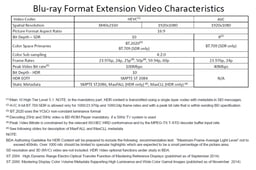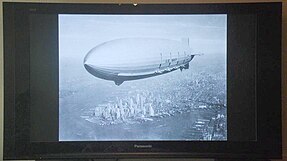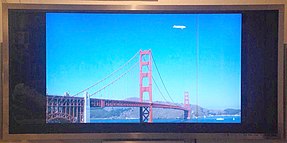21:9 aspect ratio

21:9 aspect ratio
21:9 ("Twenty-One by Nine") is a consumer electronics (CE) marketing term to describe the ultra-widescreen aspect ratio of 64:27 (2.370:1), designed to show films recorded in CinemaScope and equivalent modern anamorphic formats. The main benefit of this screen aspect ratio, compared to the more common 16:9, is the absence of the black bars at the top and bottom of the screen when viewing content in this format, and a constant display height when displaying other content with a lesser aspect ratio.
The 64:27 aspect ratio is an extension of the existing video aspect ratios 4:3 and 16:9, as it is the third power of 4:3, where 16:9 of traditional HDTV is 4:3 squared. This allows electronic scalers and optical anamorphic lenses to use an easily implementable 4:3 (1.33:1) scaling factor.


 :9. If it actually were 21:9 (2.3:1), the fraction could also be expressed in the reduced form as 7:3, relating to the 4:3 of standard-definition TVs.
:9. If it actually were 21:9 (2.3:1), the fraction could also be expressed in the reduced form as 7:3, relating to the 4:3 of standard-definition TVs.As of 2017, this ratio is rarely used in TVs, due to it causing pillarboxing with standard 16:9 content.[2] It is still prevalent in projection systems, and supported by a number of consumer electronics devices, including Blu-ray players and video scalers.
It also started to appear in higher-end computer monitors, where the term "21:9" can represent aspect ratios of 43:18 and 12:5 in addition to 64:27. The wider screen provides advantages in multitasking as well as a more immersive gaming experience.[3]
Constant image height
With content of different aspect ratios, adjustments have to be made when showing such content on a display with a fixed aspect ratio. To avoid loss of content (due to cropping) or distortions (due to stretching), horizontal or vertical bars of a uniform color, usually black to make them less noticeable, are added to adjust the image. With the black bars being unnoticed, this has the effect of a changing image image size when switching content aspect ratios.
A 21:9 display allows to present all content up to 'Scope aspect ratios at equal height, with changing vertical bars to the left and right of the image. Note how the large center circle, representing the main image area, remains at a constant size on the 21:9 display, while it changes on the other two depending on the aspect ratio of the content. [[INLINE_IMAGE|//upload.wikimedia.org/wikipedia/commons/9/92/Animated_content_4x3_16x9_21x9.gif|undefined|Animation of various content on three types of displays|h200|w800]]
Motion Picture film formats and 21:9
The "21:9" digital format's aspect ratio of approx. 2.37:1 is positioned between the classical CinemaScope aspect ratio (1678:715, approx. 2.35:1) and the aspect ratio of modern anamorphic cinematic content (1024:429, approx. 2.39:1), matching both with only a slight deviation.
Standardization
HDMI
As of May 2013, video timings in this 64:27 aspect ratio are supported by the technical specification that defines video timings for the HDMI interface, CTA 861-F:[4]
1280×720p, anamorphic pixel aspect ratio of 4:3
1680×720p, near-square pixel aspect ratio of 64:63
1920×1080p, anamorphic pixel aspect ratio of 4:3
2560×1080p, square pixel aspect ratio
3840×2160p, anamorphic pixel aspect ratio of 4:3
In November 2016, CTA (formerly CEA) published CTA-861-G[5] with these additional video timings in 64:27, as well as additional frame rates (48 Hz, 100/120 Hz UHD):
5120×2160p, square pixel aspect ratio
7680×4320p, anamorphic pixel aspect ratio of 4:3
10240×4320p, square pixel aspect ratio
All of the above timings are supported at frame rates of 23.97, 24, 25, 29.97, 30, 47.95, 48, 50, 59.94, 60, 100, 119.88 and 120 Hz.
Blu-ray
There was an effort, led by Panamorph, to add support for anamorphic video in a 21:9 aspect ratio to the HD and Ultra HD Blu-ray specifications.[6][7] Eventually, this feature was not included in the final specification.[8][9] Given that Blu-ray Discs include the letterboxing on the image, this effectively means widescreen movies will be shown in a 16:9 space, with black bars on top and bottom. The company Folded Space, also initiated by Panamorph, was working on a proprietary solution, MFE,[10][11] to put anamorphic 21:9 video onto Blu-rays in a way compatible with standard players.
Advanced Blu-ray players, like the Oppo BDP-203/205, can be put into a 21:9 output mode.[12] In this mode, the player has the capability to extract the 21:9 center portion of the movie content of a letterboxed disc, while re-arranging the 16:9 menus and subtitles for 21:9.
Streaming services
Video streaming and download services use a proprietary technical infrastructure, and are not confined to the same strict rules about frame aspect ratios as standardized distribution services (such as broadcast and optical discs). They therefore often encode content as just the active frame, without any aspect ratio adjustment bars (letterbox or pillarbox bars). Movies with a 2.39:1 aspect ratio are a natural match for 21:9 output video timings, as long as the streaming clients support such video modes, and even content with other wide aspect ratios such as 2.20:1 and 2.00:1 are inherently maximizing the use of the output frame on such systems. Amazon Prime Video and YouTube support ultrawide movies/videos, while Tubi TV does not. Netflix has now added support for ultrawide displays when viewing via web browser for recent content.
Consumer devices
Flat panel TV
All Blu-ray Disc content with 1920 horizontal resolution has 1080 vertical resolution, though in the case of widescreen formats wider than 16:9, the image appears on 16:9 displays with letterboxing. Philips' "Cinema 21:9" TV eliminates the black bars by scaling the 1920 horizontal resolution to its full width of 2560 and the 800+ pixels of CinemaScope images (actual pixel counts vary)[13][14] is scaled to 1080 with the black space cropped. The result is an image which fills the screen, but does not provide higher quality due to the use of scaling.[15] Despite the intention being to fill the screen with a non-letterboxed image, the zoom mode can result in some cropping at the edges.[16] Content with the full image at 1920×1080 can be displayed in the center of the screen with pillarboxing, and should the viewer choose to not display CinemaScope content at full width, it appears windowboxed.
Philips
Early reviews claimed that it was "one of the coolest TVs" to enter the market for some time.[16] This set was previewed in the UK in advance of its release date of 18 June 2009. Pre-release launch events were held at numerous Philips retailers throughout June 2009.
The online advertising campaign surrounding the Cinema 21:9, titled Carousel, went on to win the most prestigious award in the advertising industry, the Grand Prix at the Cannes Lions International Advertising Festival.[18]
In 2012, Philips stopped production on all its 21:9 televisions due to lack of demand.[19]
Vizio
The 58-inch TV with a panel resolution of 2560×1080 has been sold in 2012 and 2013, and has since been discontinued. A planned 50-inch model never made it to market.
LG
Samsung
BOE
Chinese panel manufacturer BOE presented an Ultra-Wide 10K 21:9 TV with a resolution of 10240x4320 (UW10K) at the 2015 Display Week conference.[27]
Front projection
Wide screen projectors with a 16:9 aspect ratio can be converted to 21:9 by attaching a 4/3 horizontal stretch or vertical squeeze anamorphic lens. This will optically scale standard projection images with e.g. 1920×1080 (FullHD) or 3840×2160 (UHD) to a 21:9 aspect ratio. These lenses are manufactured by optical companies like Isco and Zeiss, and provided to the home theater market by companies such as Panamorph.[28]
DIY anamorphic lenses have been made with 2 or 4 triangular prisms. [29]
Computer monitors
While not primarily intended for cinematic content, computer displays have also made use of this and other wide aspect ratios, marketed as 21:9, to provide expanded desktop space. Common resolutions in the market are listed below:
| Resolutions | Aspect ratio |
|---|---|
| 2560×1080, 5120×2160, 7680x3240, 8192×3456, 10240×4320 | 64:27 (2.370) |
| 3440×1440, 6880×2880 | 43:18 (2.38) |
| 1920×800, 2880×1200, 3840×1600, 4320×1800, 5760×2400, 7680×3200, 8640×3600 | 12:5 (2.4) |
Smartphones
On February 25, 2019, Sony launched their latest flagship device, the Xperia 1, with the world's first 21:9 ultra-wide 4K HDR-enabled OLED (6.5") display in a smartphone. They have trademarked the name CinemaWide for use in their latest ultra-wide Xperia devices.[33] It is not the first mobile device to use a 21:9 aspect ratio display; that recognition belongs to the LG New Chocolate, released in 2009. It has a 4" TFT display with 345 x 800 pixels and 217 ppi density. The recently-launched Samsung Galaxy Fold smartphone/tablet folding hybrid, with its 4.6" Super AMOLED cover display, and the Xperia 10 and 10 Plus are among the first modern devices with ultra-wide displays, with other smartphone manufacturers expected to follow suit after. Motorola introduced a 21:9 smartphone in May 2019, the Motorola One Vision, with a 6.3" hole-punch 1080p LCD display.[34]
Note that Sony chose to use a screen resolution of 2520×1080, rather than the CE resolution of 2560×1080, as defined in CTA-861. This leads to the device to have a "true" 21:9 (7:3) Aspect Ratio, rather than the normal CE Aspect ratio of 64:27. The Xperia 1 also has an odd Aspect Ratio of 320:137, and would have been able to meet 64:27 with a more even resolution of 3840×1620. Sony appears to take things too literal, as with their Home Theater projectors that feature a 4096×2160 4K resolution, rather than the CE resolution of 3840×2160[35]. 4096×2160 is a resolution only relevant in digital cinema (DCI), where movie theater projectors feature this resolution with either letterboxed 4096×1716 or pillarboxed 3996×2160 content for "Scope" (2.39:1) and "Flat" (1.85:1) aspect ratios, respectively. The full panel aspect ratio of 256:135 is unfit for normal consumer content with a 16:9 container aspect ratio.
| Device | Display specs and resolution | Pixel density | Date announced |
|---|---|---|---|
| LG New Chocolate (BL40) | 4.01 inch HVGA TFT (345 x 800) | 217 ppi | August 3, 2009 (2009-08-03) |
| Samsung Galaxy Fold | 4.6 inch HD+ Super AMOLED (720 x 1680) | 397 ppi | February 20, 2019 (2019-02-20) |
| Sony Xperia 1 | 6.5 inch 4K HDR OLED (1644 x 3840) | 643 ppi | February 25, 2019 (2019-02-25) |
| Sony Xperia 10 | 6.0 inch Full HD+ IPS LCD (1080 x 2520) | 457 ppi | |
| Sony Xperia 10 Plus | 6.5 inch Full HD+ IPS LCD (1080 x 2520) | 422 ppi | |
| Sony Xperia 5 | 6.1 inch Full HD+ HDR OLED (1080 x 2520) | 449 ppi | September 5, 2019 (2019-09-05) |
| Motorola One Vision | 6.3 inch Full HD+ IPS LCD (1080 x 2520) | 435 ppi | May 2019 (2019-05) |
| Motorola One Action | August 2019 (2019-08) |
See also
Display aspect ratio
Ultrawide formats









